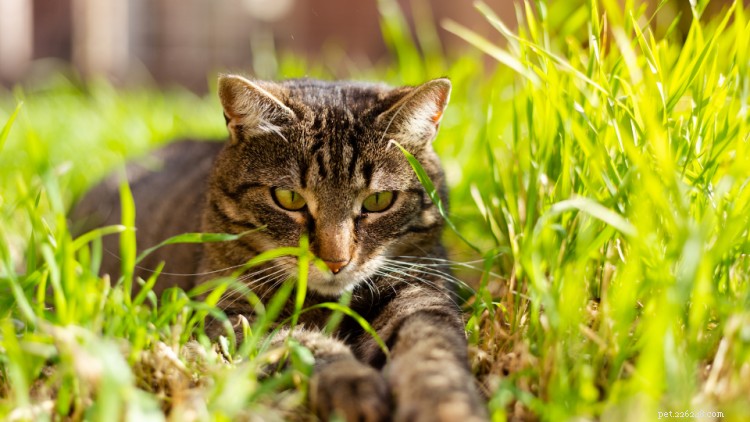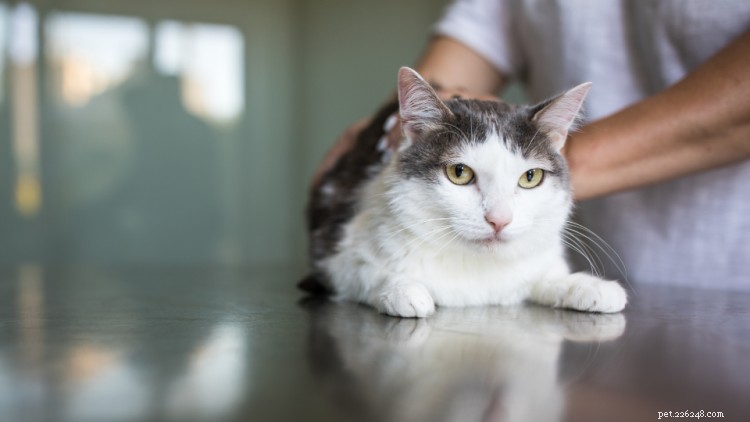サナダムシは、猫を非常に病気にする可能性のある腸内寄生虫です。しかし、これらのワームは不快ですが、特に初期段階で見つけた場合は治療可能です.
では、症状はどのようなもので、猫がサナダムシに感染しているかどうかはどうすればわかりますか?この記事では、この寄生虫とそれが猫に引き起こす病気について知っておくべきことをすべて取り上げます.
目次:
プロのヒント: すべてのペット保険は、通常、生後 8 週間の子猫を対象としています。若くて健康な年齢で猫を登録することにより、保険はサナダムシ感染症などの状態の治療費をカバーすることができます.
サナダムシは猫の腸に生息する一般的な寄生虫です .数種類のサナダムシが動物に感染することが知られていますが、猫で最も一般的なサナダムシは Dipylidium caninum です .
サナダムシは、肉眼で見ることができる数少ない種類のワームの 1 つです。それらはさまざまな長さの平らで長いワームです (サナダムシの成虫は 6 ~ 23 インチの範囲で測定できます)。これらのワームは、セグメント化された体と、フックと吸盤のある頭を持っています。サナダムシが成長し始めると、セグメント (proglottids と呼ばれる) ) 卵で満たされ、体から分離され、便を通過する米粒のように見えます.
他の腸内寄生虫(鉤虫や回虫など)とは異なり、猫は卵を食べてサナダムシに感染することはありません。 ワームは、猫に感染する前に、まず中間宿主を通過する必要があります .

猫は、ネズミなどの感染した小動物や感染したノミを食べることでサナダムシに感染します。ノミの幼虫はサナダムシの卵を食べ、幼虫が成長してノミの成虫になります。感染したノミが猫に付着し、猫がそれを食べると (例えば、毛づくろい中)、猫も感染します。猫がノミを摂取すると、サナダムシの卵は無傷で猫の腸内に放出されます。孵化し、腸の粘膜に付着してライフサイクルを完了します。
サナダムシは、ノミが大量に寄生している環境でより一般的であり、犬やすべての品種、年齢、性別の猫の感染リスクを高めます。
まれですが、人が感染することもあります ジピリジウム・カニナム 汚染されたノミを食べることによるサナダムシ。小さな子供は大人よりも衛生に関心がないため、リスクが高くなります。
Echinococcus と呼ばれる、あまり一般的ではないサナダムシの別のグループ 人間の健康により重大な脅威をもたらす まれではあるが致命的な病気を引き起こす可能性があるためです。 エキノコックス 感染症は、Dipylidium よりも診断が難しい セグメントは小さく、肉眼では見えないためです。包虫症または包虫症と呼ばれる病気の症状は、何年も現れない場合がありますが、肝臓に嚢胞が形成されます.
多くの場合、サナダムシに感染した猫は臨床症状を示さない .最も一般的な症状は、猫の糞便または肛門周囲に存在するサナダムシの断片です。
ネコ科の友だちが常におしりを舐めたり、引っ掻いたり、噛んだりしたりする場合 , they might have tapeworms. Your cat might also drag their hind legs across the floor in an attempt to scratch the area, but this is more commonly seen in dogs.
When tapeworms are present in large numbers, they can lead to weight loss , even if your pet's appetite remains unchanged. Cats with tapeworms will also have a shabby and dull coat , and some might experience diarrhea and vomiting . In some cases, a tapeworm will migrate to the cat's stomach, causing the animal to vomit a worm.
If you notice any of these symptoms, be sure to have your pet examined by a vet. Although tapeworms are not particularly harmful to cats, you should still take them seriously. If left untreated, tapeworms can cause intestinal inflammation and secondary health issues.
Older cats and kittens are especially susceptible to the adverse effects of intestinal parasites. In extreme cases, kittens may develop intestinal obstructions from adult tapeworms. Senior cats might develop inflammation in their gastrointestinal tract, resulting in chronic vomiting and loss of weight.
Fortunately, tapeworms are easy to treat if they're detected early.

A vet must diagnose a cat with tapeworms , usually after the owner detects the parasite around their pet's anus or in their feces. Unlike other parasites, fecal float tests aren't as helpful in the detection of tapeworm infection.
In some cases, a tapeworm diagnosis can be difficult because cats are fastidious groomers. They may clean the grain-like segments from their rear end or bury their poop in the litterbox before anyone can notice the evidence of infection.
Treatment for tapeworms is a simple process that requires deworming medication administered orally or by injection . After treatment, the tapeworms usually dissolve in the intestines, so you will no longer see segments in the affected cat's feces.
New tapeworm medications and flea preventives are safe, effective, and cause very few or no side effects. The prognosis for successful treatment is excellent, but in flea-infested environments, the infection might become re-established within several weeks. Effective flea control is also required to clear the infection.
Your vet can provide the best advice on the deworming medication most suitable to treat your cat's tapeworm infection.
プロのヒント: Cat insurance can cover the cost of diagnostic testing, prescription medication, annual veterinary exams, and more with optional wellness plans that offset expenses for routine care, including flea prevention. Compare pet insurance plans to find the right coverage for your needs with flexible options you can customize.
When it comes to preventing tapeworms in cats, flea control is crucial . All cats, young and adult, should be on flea prevention monthly unless using a product that lasts longer than one month. Ask your vet which flea and tick prevention products they recommend for your specific cat.
If your cat is recovering from a flea infestation, extra precautions may be necessary. Wash all of the cat's bedding and toys in hot water, and sanitize the litter box daily. Be sure to dispose of your cat's feces properly and teach your children safe hygiene practices after playing outside.
If you have a little hunter or huntress on your hands, it's a good idea to try to stop your cat from chasing mice and other small animals that could be intermediate hosts. Cats who love chasing prey should see the vet regularly, regardless of whether they're showing any symptoms of tapeworms. Make an appointment for intestinal parasite testing and deworming once every three months.

重要なポイント 白癬は、猫と犬の両方によく見られる真菌感染症であり、人間にも発生する可能性があります。猫の白癬の症状には、発疹、円形パターンの脱毛、炎症を起こした皮膚、過度の身だしなみなどがあります。白癬は経口薬と局所薬の組み合わせで治療できるため、猫に白癬があると思われる場合は、獣医から診断を受けることが重要です。 白癬は寄生虫のように聞こえるかもしれませんが、実際には猫の皮膚、髪の毛、または爪に影響を与える真菌感染症です。イヌ小胞子菌として知られる真菌は、猫の白癬症例の98%の原因です。白癬は通常、顔、耳の先、尾、足に発生します。この真菌感染症は、動物から動物へと容易に広がる可能性があり

重要なポイント 猫の糖尿病は、特に年配の太りすぎの猫によく見られ、治療法は知られていません。しかし、適切な治療を行うことで、猫の糖尿病を管理することができ、猫は快適で幸せな生活を送ることができます。猫の糖尿病の治療オプションには、インスリン注射、食事の変更、血糖値のモニタリングなどがあります。 猫の糖尿病は、高齢の太りすぎの猫に最もよく見られる深刻な健康状態です。 あなたの猫が糖尿病にかかっていると聞くのは憂慮すべきことですが、幸いなことに、この状態は適切な治療で対処できます。糖尿病を早期に発見して適切に治療する限り、猫は幸せで長生きすることができます。 このガイドでは、猫の糖尿病